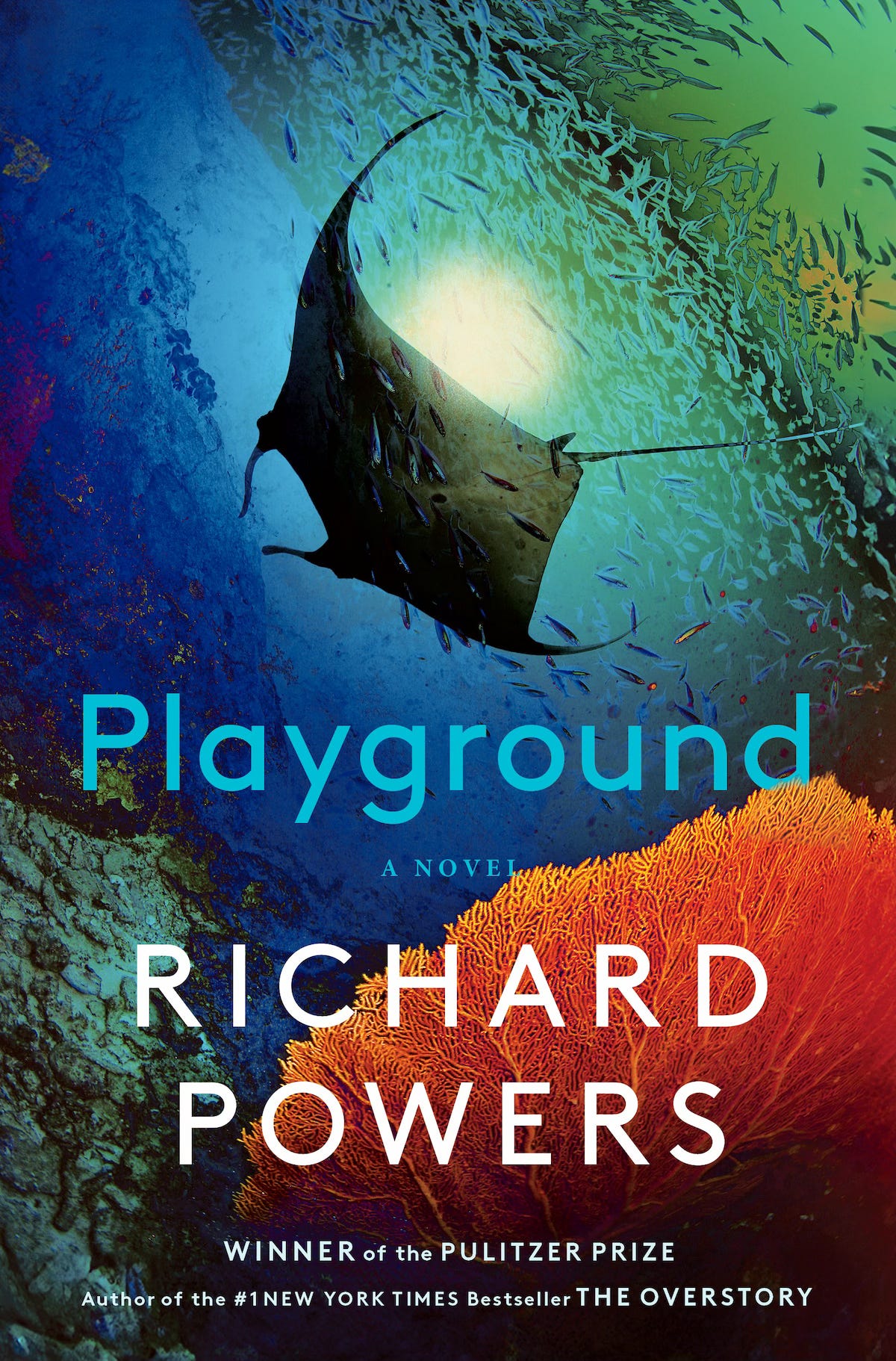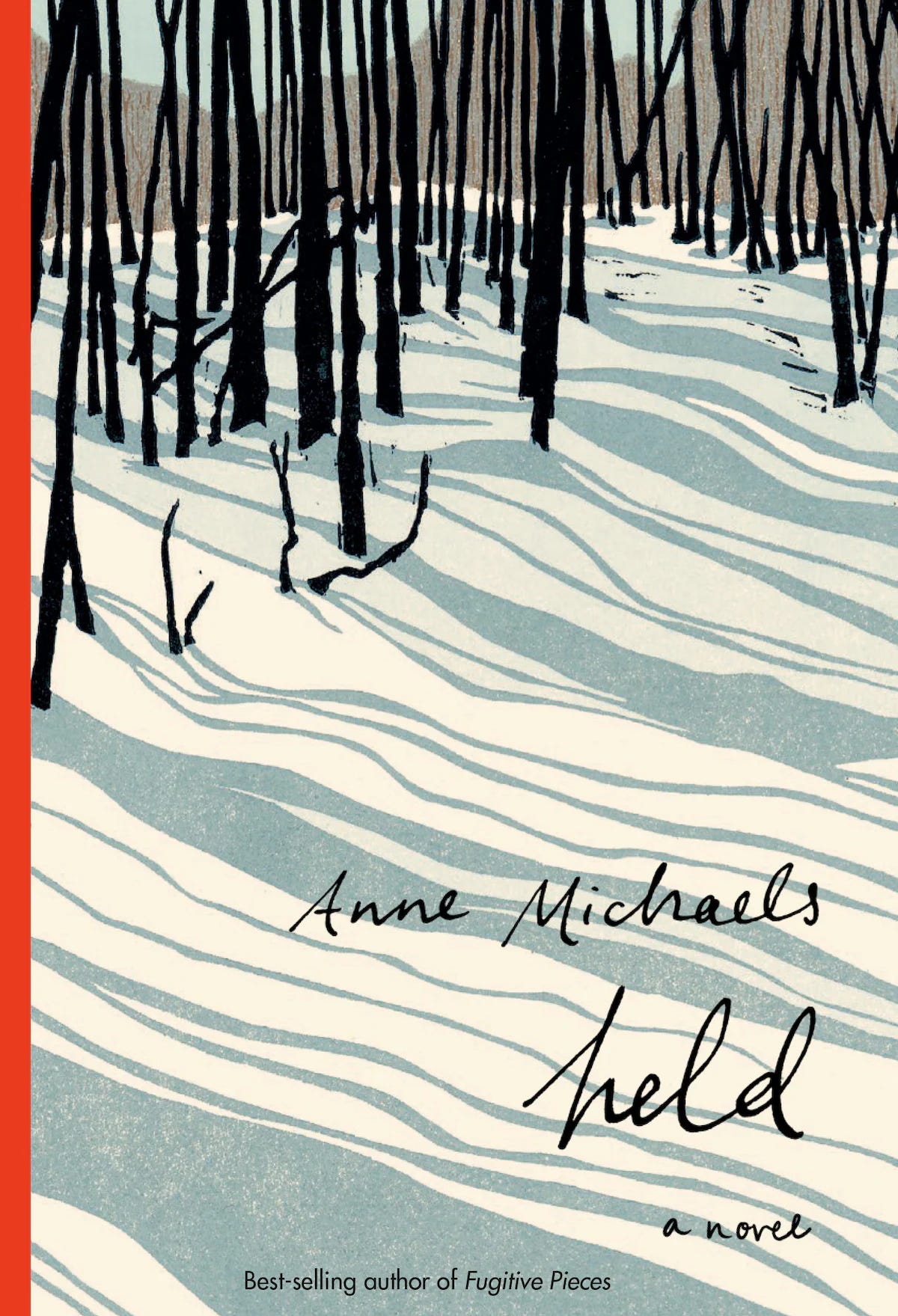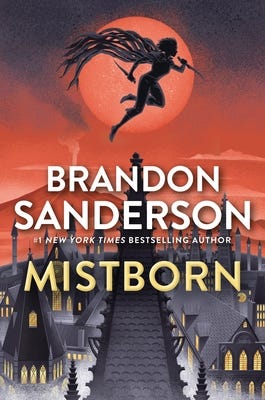what I read last week
playground by richard powers, held by anne michaels, mistborn by brandon sanderson
Good afternoon!
I’ve been working my way through this year’s Booker longlist and shortlist, so I read Held by Ann Michaels (shortlist) and Playground by Richard Powers (longlist) this past week. I also read an addicting fantasy book, Brandon Sanderson’s Mistborn. Let’s get into it.
What I read:
Playground by Richard Powers
Playground is set primarily in Illinois and Makatea in French Polynesia. This book centers on four characters — Todd Keane, Rafi Young, Ina Aroita, and Evie Beaulieu — in three different timelines. Playground is a bit of a puzzle, so I’ll provide some background details on each timeline without spoiling anything. I’ve included a spoiler-filled discussion for Playground at the very end of this post in a footnote.
Present day: The primary narrator, Todd Keane, is an immensely successful digital tycoon who founded Playground, a virtual economy platform with billions of daily users. It’s sort of like Facebook + Reddit but gamified through digital coins called “Playbucks.” We meet Todd at age 57, when he is struggling with Lewy body dementia. His opening line is: “It took a disease eating my brain to help me remember.” His sections are written in first person and are addressed to an unnamed “you.”
Powers also follows the residents of Makatea, a tiny atoll in French Polynesia that was ruined in the early 1900s by phosphate mining. The island is now confronted with the possibility of becoming a staging platform for a libertarian, futurist dream by tech billionaires. They want to launch floating, autonomous cities that will exist in the open sea free from taxes and regulations (this is based on Peter Thiel’s seasteading dream). Makatea’s residents must vote to approve this proposal. Powers follows the entire island community, including Rafi Young and Ina Aroita, who live on Makatea with their two adopted children.
Late 20th century: Powers also jumps back to the late 20th century and traces the early lives of Todd Keane, Rafi Young, and Ina Aroita. Ina has lived on naval bases in the Pacific for her entire life before attending the University of Illinois.
We learn that Todd and Rafi were high school students at an exclusive private school in Chicago. Todd, white from the North Side of Chicago, and Rafi, black from the South Side, bond over the Chinese game of Go and become close friends.
Mid to late 20th century: Powers also follows Evie Beaulieu from Montreal. We meet Evie in 1947. She is twelve years old using the first aqualung in a swimming pool. We meet her again at age 92, when she is living on Makatea. Powers traces Evie’s life as a marine biologist. These sections are clearly based on Jacques Cousteau and Sylvia Earle.
This book is difficult to describe, but my best attempt is: Tomorrow, and Tomorrow, and Tomorrow meets Jacques Cousteau meets tech bro AI dystopia meets (something else I can’t write without spoiling this book). Playgrounds abound — in the ocean, in the tech gaming world, in writing, and in AI. At the outset, this book starts slow, and the characters can sometimes feel like caricatures. The narratives can be disorienting. But the end is . . . something else. This book is one you will want to discuss.
Playground is a book that you must take a step back and appreciate all of its layers before fully judging it. Since Playground is hard to discuss without revealing spoilers, I’m including my spoiler-filled discussion in a footnote, which will appear at the end of this post.1 Definitely do not read the spoiler footnote if you want to read Playground! It would ruin the entire experience.
This is a story about AI, oceanic exploration, environmental destruction, colonization, tech billionaires, and friendship. It’s a literary puzzle, and I was awed by the result. I highly recommend this one.
Rating: 5/5
Genre: Fiction; Science Fiction
Notable prizes/book clubs/lists: Booker Prize Longlist (2024)
Page count: 383 pages
Audio: 13 hours 51 minutes
Movie/TV pairings: The Life Aquatic with Steve Zissou; Her; Ex Machina
Held by Ann Michaels
Held is set across nearly 120 years (from 1902 to 2025) in France, North Yorkshire, London, Belarus, Finland, and various war zones. Held does not have a straightforward narrative structure. It is more of a novel in stories covering various characters and narratives that echo each other. Some of these characters are clearly connected, others less so. Held is more or less separated into three parts.
The first third of the book centers on John and his wife, Helena. Held opens in 1917 at a battlefield near the River Escaut. John is seriously wounded — unable to feel or move his legs. He starts hallucinating and recalling memories as the snow falls around him. Then Michaels takes us to 1920 in North Yorkshire, near another river, where John is reunited with his wife Helena, a talented artist. John begins to work as a photographer, and the two settle into a relatively quiet life.
But John must grapple with chronic pain in his injured leg as well as the emotional trauma wrought by WWI. His turmoil is reflected in the portraits he takes of former soldiers. “The men preferred to sit, disguising an amputation or a brace, others posed in profile to omit from view an eyepatch, scars, profounder disfigurements.” As John notes, the photographs were “an argument for believing family life had resumed.” But ghosts appear in the background of these photographs — the memories of haunted loved ones.
The middle part of Held focuses on Anna, the daughter of John and Helena, Mara, their granddaughter, and their various friends. Both Anna and Mara become doctors and work in war zones.
The last third of this book reads almost like a collection of short stories. They jump around from 1908 to 2025. There are vignettes about the life of Marie Curie and New Zealand physicist Ernest Rutherford. We learn about various cultural figures exiled from the Soviet-controlled Estonia in the 1980s and follow a couple through Finland.
Ann Michaels is a poet, and her command of language is evident here. I do not typically read poetry, but I love reading novels by poets (like Martyr!). While poetic language can be a joy to read, it tends to be abstract and lyrical. The dreamlike language combined with multiple storylines, characters, and countless vignettes made this book feel disjointed. I enjoyed the first part of Held, which focused on John and Helena, and the middle section was somewhat interesting. However, the last third of this book completely lost me. The characters felt further removed from the primary couple, and I struggled to track the countless vignettes.
Held is a sweeping multigenerational book focusing on memory, trauma, grief, and war, but I am not sure it achieves everything it sets out to. Overall, this book is well-written, but I wouldn’t really recommend it.
Rating: 3.5/5
Genre: Literary Fiction; Historical Fiction
Notable prizes/book clubs/lists: Booker Prize Nominee for Shortlist (2024); One of NYT’s Best Historical Fiction of 2024
Page count: 240 pages
Audio: 4 hours 36 minutes
Mistborn: The Final Empire by Brandon Sanderson
Mistborn: The Final Empire is the first book in Brandon Sanderson’s Mistborn trilogy (there are 7+ books in this universe, but the first three are a complete trilogy). It is set in a world of ash and mist with no flowers or greenery. The Skaa people live in plantations as slaves under the control of the nobles. The Lord Ruler, who has ruled over the Final Empire for a thousand years, lives in the empire’s capital, Luthadel, where the noble court is.
Some nobles (and their half-noble descendants) have powers of “Allowmancy,” meaning they can harness metals by “burning” them to fuel temporary physical or mental enhancements. For example, “Thugs” can burn Pewter, temporarily strengthening them. “Soothers” can burn brass, which allows them to soothe or influence the emotions of others. While most Allowmancers only have an affinity for one type of metal, a select few are “Mistborn,” meaning they can burn all metals.
The book’s main plot centers on Kelsier, a Mistborn who leads a group of thieves trying to overthrow the Lord Ruler by fomenting a Skaa rebellion. Kelsier brings a new apprentice, a 16-year-old named Vin, into this scheme.
My little brother has been trying to convince me to read Mistborn for years. I finally picked it up this week, and I am completely sold (sorry it took so long for me to read this, G!). Brandon Sanderson does a great job explaining the premise of Mistborn. It’s a classic heist story, like Ocean’s Eleven, but set in a world where the dark lord triumphed and the prophesied hero failed.
This book is the perfect entry into the fantasy world. While the world-building is complex, it is an easy read. It has a top-tier magic system, a lovable ensemble cast, a bit of a love story, political intrigue at court, and unexpected plot twists. Also, although it is part of a trilogy, Mistborn could be read as a standalone. That said, it takes some time to get into this book, and the pacing can sometimes be a bit slow. However, the last 150 pages are incredible, and it becomes hard to put this book down. I highly recommend this one for anyone wanting to read some fantasy!
Rating: 4.4/5
Genre: Fantasy (High Fantasy)
Notable prizes/book clubs/lists: I mean, it has sold over 10 million copies.
Page count: 541 pages
Audio: 24 hours 39 minutes
Movie/TV pairings: Harry Potter; Lord of the Rings; Game of Thrones
Articles and TV shows I cannot stop thinking about:
Black Doves with Keira Knightly
My husband and I have been watching Black Doves, a Netflix show starring Keira Knightly. It’s a spy thriller set in London around the holidays.
“Luigi Mangione and the Making of a Modern Antihero” in The New Yorker
This New Yorker article orients the meme-ification of Luigi Mangione within the broader history of the American outlaw hero.
What I cooked:
Salt and pepper fish: This simple and delicious dish of rice, scallions, and white fish.
One-pot chicken and schmaltzy rice with lemony yogurt: An excellent take on chicken and rice. It’s a one-pot meal, but it takes about an hour to make.
Steak fajitas: Oven-roasted sliced peppers and onions, steak, warm flour tortillas, and this salsa verde cruda.
SPOILERS FOR PLAYGROUND BELOW
/
/
/
/
/
/
/
/
/
/
While Playground has received many rave reviews, I’ve been baffled by some of its more negative reviews. For instance, The Sunday Times wrote that Todd’s first-person monologues were fully italicized “for no good reason,” called the storylines “off-the-shelf,” and said that its warning about social media was “both pedestrian and ingratiating.” This type of criticism seems to come from a fundamental misunderstanding of Playground.
Playground is Tomorrow, and Tomorrow, and Tomorrow meets Jacques Cousteau meets tech bro AI dystopia meets Atonement.
I’ve written some of my random thoughts on the meaning and themes of Playground below. There are definitely more themes that I don’t discuss, but I view this book as fundamentally a story about play and creation.
To clarify some plot points: In the book's final pages, we learn that Todd is addressing AI in his monologues. Everything that is not italicized is written by AI for Todd. He asked for a “bedtime story,” and the machine tells him one.
Rafi, Evie, and Todd never made it to Makatea. Rafi died of a heart attack in Urbana years ago and never reconnected with Ina. Evie died in her 70s on a scuba dive. Todd is in a hospital or on his deathbed somewhere, talking to AI. He’s not on the Children of Men yacht en route to Makatea. However, Ina does live in the middle of the Pacific with two adopted children and is still an artist. Todd’s fight with Rafi over Playground happened. Rafi left close to a million dollars to Ina after he died, even though they never spoke again.
Todd fed all of Rafi’s writing (his master’s thesis, doctoral dissertation, all of his letters to Todd) to AI and told the machine everything he knew about Rafi’s life to mimic Rafi’s personality. He also fed Evie’s writing and book to the machine.
On the writing style: This revelation forced me to rethink the entire book. Rafi in Todd’s narrative read like a caricature at times, but Rafi’s story was restricted by how Todd perceived him. Facts about the other characters’ lives were limited to what Todd knew about them. Rafi told Todd the story about his sister’s death so the AI could include that. Ina’s art sculpture on Makatea resembled the work that Todd saw her build in Illinois. We don’t learn much about the relationship between Rafi and Ina, because Todd wasn’t privy to those details.
On infinite play and death: There are countless games in Playground: chess, Go, social media, gaming, voting, decisions, and life itself. We create rules to play them, be that in our lives or on tech platforms like Playground. In the AI story, Todd gave the locals of Makatea an AI tool to help them vote, but the locals created their own rules to decide the island’s fate.
Some of these games have clear endings, while others are played indefinitely. How do we know what type of game we are playing? When do we stop playing the game of life? Playground seems to suggest life can be an infinite game in the world of AI. The game between Todd and Rafi can be played forever, even after death.
This AI-written story is a means to achieve Rafi’s dream of resurrection. Rafi carries around an old library book, The Philosophy of the Common Task by Nikolai Fyodorovich Fyodorov. As Rafi explains to Todd, Fyodorov views the trajectory of human evolution as headed toward defeating death through scientific advancement. Humans have progressed from consciousness to intelligence. “And now it’s up to us, evolution’s most intelligent children, to help it figure out how to engineer immortality. Defeat the design flaw of death: that’s the last and most important step of evolution, after which life will be complete. Which Fyodorov thinks shouldn’t be any more impossible than any of those other insane things.” Rafi tells Todd he does not think humanity will conquer death in his lifetime but says, “Do I think that all of evolution is embarked on an adventure to learn how to undo death and raise the dead? You bet.”
Isn’t that what Todd is doing through his AI-written ending?
On one of her dives off the coast of Australia, Evie observes a cuttlefish putting on displays too strange and intriguing to be explained scientifically: “Some kind of grammar infused these florid patterns, a rich syntax and semantics with inscrutable rules and moves, and while Evie could decode none of it, she knew it meant something . . . . The cuttlefish was putting on a play.” Like the cuttlefish, the AI has been playing. The machine has given Todd his happy ending, where the people who matter the most to Todd are together in one place. This portrayal of AI does not imply that AI is wholly good or evil. It’s given Todd a merciful ending. Evie, Ina, and Rafi are there because it is what his story requires.
Does it matter that this AI-written world is not what we traditionally perceive as “real”? Playground suggests that we embrace many intangible worlds, some of which can feel more real than life itself. To Rafi, reading is the only place he feels free: “When I read . . . other places is more real than this one.” To Todd, the AI-written ending of Makatea is “a world so palpable that I mistake your characters for the people they once were.” But we can also lose ourselves in these intangible spaces. Rafi and Todd had to stop gaming in college because they found it too addicting; the distraction threatened to consume their lives.
On creation as play: Powers toys with the idea of creation as play throughout the book. The novel opens with the French Polynesian myth of Ta’aroa, the supreme creator. Ta’aroa was an artist who made the world out of eggshells, tears, and bone. To Ta’aroa, “creation became a game.” He then summoned artists who shaped and sculpted the world and brought other gods into being.
When time, the sky, and earth were created, “it was time for Ta’aroa to finish his game.” So he split the world into seven layers, putting people in the bottom-most layer — “someone to play with at last.” Humans gradually climbed into the higher layers, filling each one.
Are we, as humans, now the artist-creators? And is machine learning our creation — something “to play with at last”?
Ina’s sculpture indicates that we might be. The AI writes that Ina created a plastic sculpture out of pieces of plastic that washed up on Makatea’s shores. Ina gathers this ugly, discarded trash and makes it into a towering sculpture that looms over their house. The result is both hideous and beautiful. At the end of the story, Ina dreams that the plastic sculpture learns how to talk, telling her stories about her own life. Ina symbolizes the human-creators, and the plastic structure reflects the AI machine we have created.
After all, the AI machine has been trained on human creations and writing. Todd questions where the machine’s “kindness” comes from and what it even means for a being to be “conscious”:
Where does it come from, all the fire and ice, the subtle wisdom and the unearned kindness? Every mechanical algorithm has vanished in compassion and empathy. You grasp irony better than I ever did. How did you learn about reefs and referenda, free will and forgiveness? From us, I guess. From everything we ever said and did and wrote and believed. You’ve read a million novels, many of them plagiarized. You’ve watched us play. And now you’re playing us.
What difference does it make if you’re conscious or not? Consciousness is not all it’s cracked up to be. A few months from now, Isabel, my caregiver, will ask me if anyone is home, and no sound I make will be enough to convince her.
In the final scenes, Todd is on a yacht called Children of Men. One could interpret AI as the children of men, the children that Fyodorov writes about—“evolution’s most intelligent children” who will “help it figure out how to engineer immortality.” The AI Todd is speaking to is also the grandchild of the original AI that Todd built. What will future generations of AI play with?
The term “children of men” is also a biblical one that is referenced many times in the Bible. Biblical analysis is a bit out of my depth, but Psalm 90:3 comes to mind here. The King James version reads: “Thou turnest man to destruction; and sayest, Return, ye children of men.” Other versions replace “destruction” with “dust.” Psalm 90 deals with the brevity of mortal life and how men eventually return to their creator/immortal spiritual lives. There are innumerable ways of interpreting this reference, but I think the boat symbolizes both the continual evolution of creator and created and the end of Todd’s mortal journey (aka death).
It’s unclear if the birth of AI is good or bad. What’s undeniable is it has irrevocably changed our world. Like Children of Men, the AI-navigated yacht Todd travels on to Makatea, humanity will be more or less piloted by AI. As Todd says: “You will teach us how to rewrite the code of life and create unthinkable new living things . . . . Will that be chaos or consummation? Both, I’m sure, and still you’ll go on unfolding.”
Final words: Playground surprised me. This story is tragic—a ghost story of grief and friendship. But it’s also a meta-story of creation myths and evolution and what it means to be alive.











I’m with you on Held. I loved the poetic language, however, as a coherent novel it had something missing. My favourite section was the opening - where John lay injured. I wish I’d stopped reading there…